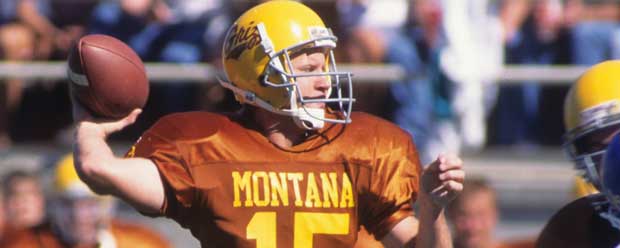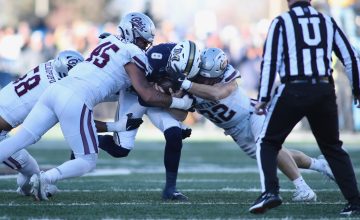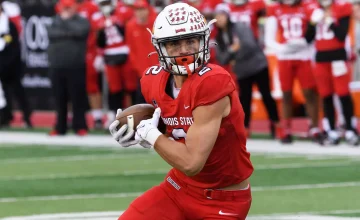It was a cold day on November 27, 1993, the last time the Delaware Blue Hens visited Washington-Grizzly Stadium.
The pregame weather report read 6 degrees.
The fans, Sherry Devlin wrote in the Missoulian, “displayed remarkable resourcefulness in staying warm. There were stocking caps beneath baseball caps, fur – fake and otherwise – coats, at least one coonskin hat and blankets tied around heads and waists.”
Phenomenal stuff, no doubt – however, Devlin could only lay claim to the second-best weather-related line that appeared the next morning in the almost unfathomably robust – 10 pages! – Sunday sports section of the hometown newspaper.
“The silence,” Kim Briggeman wrote about the final seconds of the East Coasters’ 49-48 upset of the No. 2 Griz, “was as deep as winter.”
It was, surely, a shocking loss.
Dave Dickenson threw for 409 yards and four touchdowns for the Griz, who entered at 10-1 with their only loss a 35-30 nailbiter at Oregon in September.
Montana had two 100-yard receivers – Matt Wells and Scott Gurnsey – and a go-ahead kick return touchdown from Damon Boddie in the final three minutes.
But the Blue Hens and their baffling Wing-T offense – “A couple times I went up to make the play on a dive or something, and the ball was over there,” safety Carl Franks was quoted as saying – ran the ball 56 times for 474 yards, had 598 yards in all and won the game with 55 seconds to go when Leo Hamlett floated a 32-yard touchdown to Keita Malloy, who also started at cornerback for Delaware.
“We couldn’t stop the run, and they beat us with the pass,” Franks said, disgusted emphasis added by Missoulian sports editor Bob Meseroll, while Griz coach Don Read was similarly left searching for answers.
“We hadn’t seen anybody this year stop ‘em, but we thought we could slow ‘em down a little better than that,” Read said.
As the Blue Hens prepare to visit Missoula in another early-round playoff matchup with eerie parallels to 30 years ago – Montana is the No. 2 seed once again – it’s also worth revisiting what came out of that shocking late-November loss.
In the immediate aftermath, with dreams dying and careers ending, the Griz didn’t have much to say.
“Yeah, next year,” said Boddie, just a junior. “But it would have been nice to do it this year.”
But that deep winter silence also contained the seeds of the run the Griz would embark on over the next two years, one that would culminate in a national championship.
“It was so abrupt,” Gurnsey remembered in the present day. “I remember going home for Christmas and then getting back and getting winter conditioning started. The (rising) seniors just said, you know, this is the last shot we have at this. We had this kid, Double D, Dave Dickenson, who’s going to be the guy, and we end up having a great year in ‘94, made it to the semi-finals, lost to Youngstown State.
“And then you know what happened in ‘95.”
What happened, of course, in 1995 was a run all the way to the national title game, where the Griz beat Marshall 22-20 on a last-second field goal by Andy Larsen.
1995 was the season that cemented Dickenson as an all-time Griz great, but it was the culmination of a three-year progression that started with that 1993 team.
Montana had made the FCS Playoffs twice in a row under Read in 1988 and 1989, making it to the semifinals in the latter year, but hadn’t been back since.
In that sense, even though the Delaware loss made the 1993 season a disappointment, it also served as an important milestone, a marker laid down.
“I thought our 93 team was actually a great team, we just didn’t know how great we were, so we just kind of rode the wave,” Dickenson said. “That group was a great group. We were great up front and at linebacker and all that, but we kept a certain amount of guys for the ‘94 and ‘95 runs.”
That included Dickenson, obviously, but also players like Wells, who led the 1995 team with 1,318 receiving yards as Dickenson threw for a scarcely believable 5,676 yards and 51 touchdowns in 15 games.
Mike Bouchee, a freshman in 1993, led the ‘95 Griz with 123 tackles. Jason Crebo, who redshirted in 1993, had 102, and 20.5 tackles for loss.
“Some guys would argue all the different teams, but that (1993) class, that was a talented team,” Crebo said. “Looking back, I would argue maybe one of the most talented. Obviously Dave was younger at that time, and obviously he was successful. I think that team was a championship level team. Those two classes with (Todd) Ericson and (Dan) Downs and those guys, to me that team was loaded for sure.”
Yohanse Manzanarez was a key contributor in both 1993 and 1995, but several other defenders, like Blaine McElmurry, Cory Falls, David Sirmon and Sean Goicoechea, matured from backups to starters over the course of three seasons.
That group suffered through playoff heartbreak in both 1993 and 1994. The year after the Delaware loss, the Griz ascended to No. 1 for a couple weeks in the regular season, dropped out of the top 10 after back-to-back losses against Boise State and Idaho State, walloped the ‘Cats 55-20 in the rivalry game and then won two home playoff games by a combined five points before losing 28-9 to Youngstown State in the semis after Dickenson got hurt midway through the game.
“I felt like ‘94 could have been special as well, but we started hitting the injury bug.” Dickenson said. “I played maybe a quarter of the playoff game and we ran into a buzzsaw at Youngstown, they were the better team. But I thought in ‘95, we were peaking.”
That’s exactly what the Griz did, although the rankings never reflected it. After smoking No. 3 Boise State, they rose to No. 5. A loss to Idaho in a wild 55-43 shootout at the Kibbie Dome midway through the conference season dropped them back to No. 10.
But after Delaware and Youngstown State, Montana now had a group that was used to bouncing back.
“If you remember in ‘95, we got whupped by Idaho late in the year, and that was a good thing for us,” Dickenson said. “It was. We figured, uh oh, we’d better show up.”
From there, the Griz won seven straight – three in the regular season and four in the playoffs, the first three by ridiculous scores (48-0 over Eastern Kentucky, 45-0 over Georgia Southern, 70-14 over Stephen F. Austin) before squeaking by Marshall in the title game on Larsen’s field goal.
Two years before, Larsen’s missed extra point after Boddie’s kick-return touchdown was what gave Delaware their one-point final margin on a cold day in Missoula.
In 1995, he was perfect – an appropriate capper for a run forged, in part, by that deep winter silence in 1993.
“We were incredibly motivated,” Bouchee said. “Very shortly after we lose those games, we were back in the weight room, we were back watching film, we were back trying to figure out where we came up short and what we needed to do to improve. Our desire to win and take that team to the next level was an incredible motivator for our team to do what it took as a team to get there.”














